Google Algorithm Important Updates (2000 to 2022) – Every Digital Marketer Must Know
The leading search engine Google rolls out several algorithm updates every year. Many of these are minor and go unnoticeable because of delivering very low impact on website ranking but some algorithm updates, at least one a year also known as ‘broad core update’, change the current ranking of websites drastically.
Here we compile an up-to-date guide of all the important Google algorithm updates that all the SEOs and digital marketers need to know because these are still effective to fix the website rank on SERPs. This guide will help you know many Google algorithm updates you may not be aware of.
This Google algorithm guide will answer some important questions also that many newbie and experienced SEOs and website owners have in mind.
What is a Google ranking algorithm update?
Google ranking algorithm update is the information about the changes in the way Google will rank the websites after the complete rollout of the algorithm update.
Google Core Update May 2022 (Year 2022)
This core update is more significant than the previous versions. The Google team says that there may be nothing wrong with web pages having a jolt in ranking after this core update. Providing the quality best content created by the experts with authority across the overall online presence is the only solution to recover from the impacts of this and other core updates. AI-generated content used to manipulate search results may not be valuable for SEO purposes after this core update.
Product Algorithm Update (Year 2022)
This product review update comes with additional criteria to rank websites. It is more important for eCommerce websites which will need to post valuable product reviews quality enriched with specifics, benefits, imitations, comments of existing users, comparable products, links to manufacturers, etc.
Product Review Update (Year 2021)
This update took 20 days to be rolled out in complete. Regarding this considerably big update, Google recommends using more multimedia relevant to product reviews and to provide backlinks to multiple sellers for the ease of buyers to decide and buy. Expertise and authenticity will also work as trust factors to support the website ranking.
Local Search Update (Year 2021)
Google rolled out this algorithm update to rebalance various factors responsible for fixing ranking in local search results. After this update, factors like distance, relevance, and prominence will become more important to fixing a website’s rank in local search results.
Google Spam Update (Year 2021)
Google had already released three Spam updates before releasing a new Spam update on November 3, 2021. This update is to filter out dubious and harmful websites using Black Hat SEO techniques and not following Google Webmaster Guidelines – thus serving no value to users.
Link Spam Algorithm Update (Year 2021)
This update is majorly focused on sponsored guest posting, affiliate links, and paid links. The websites with unnatural links across multiple languages were penalized the most. Irrelevant paid links or links created under a contractual agreement lost their importance as they had to affect the ranking.
Page Experience Update (Year 2021)
After the completion of the rolling out of this update in August 2021, page experience for users has become a ranking signal. Page Experience update evaluates the number of signals that contribute to the browsing experience of users. Core web vitals, security issues, mobile usability, popups’ experience, etc are some of the page experience signals that will contribute to fixing the web page ranking.

Multitask Unified Model (MUM) Update (Year 2021)
This update advanced Google’s search engine to provide the best relevant results for each query after interpreting and analyzing videos, images, and podcasts also available in multiple languages.
Product Reviews Update (Year 2021)
This Google’s product reviews update is aimed at product testing and product reviewing websites to support the quality trustworthy content created as per E-A-T guidelines. The affiliate sites being promoted with the primary purpose of clicks or commissions instead of providing value to users were the worst hit.
Passage Ranking Update (Year 2021)
It is a new algorithm tech to rank individual passages of a web page in search results. Google search engines will now consider relevant-to-query passages on a web page as the additional ranking factor. It is a small adjustment in the ranking algorithm for Google search engine to interpret the content better.
Google December 2020 Core Update (Year 2020)
This algorithm update was rolled out to improve the content interpretation and understanding of search intent. The websites providing no personal touch to users and giving an impression that the content is mass-produced were the most affected. The large size websites having low authority and irrelevant content were the worst hit.
Google May 2020 Core Update (Year 2020)
This core algorithm update made content, user data, and brand factors more important to rank by readdressing ranking factors. May 2020 core update also made E-A-T signals more important ranking factors. Well-established quality business websites benefited while the websites in YMYL categories came across tougher challenges to reframe their SEO strategies.
Google January 2020 Core Update (Year 2020)
As an extension of the Medic update, this update primarily affected the websites related to the finance and health sectors and penalized those websites that were found to have low credibility and trust factors judged based on their backlink profiles. This update was aimed to encourage businesses to improve domain-level trust.
BERT Update (Year 2019)
BERT update was an advanced version of Hummingbird and RankBrain updates that increased the use of natural language processing (NLP) technology to interpret search intent and deliver the most relevant results. The websites having well-constructed quality content were awarded for better ranking.
Medic Update (Year 2018)
Medic update affected the websites poor in no ‘Expertise, Authority, or Trust signals (E-A-T)’ and related to money and health categories. The websites related to medical, health, money, and other life-style altering topics were the worst sufferers. Google’s intention behind rolling out the Medic update was to provide trustworthy search results to users querying about money or health-related terms/issues.
RankBrain Update (Year 2015)
RankBrain was a tweak to the Hummingbird algorithm that was rolled out to add an additional touch of personalization to search results provided based on users’ intent. RankBrain is a Machine Learning Artificial Intelligence (AI) System that helps Google understand intent behind the search queries (ambiguous queries) to relevant search results. After the RankBrain update, Google started to favor the websites that were having quality information relevant to search intent, personal search history, and language. The web pages with content created without the use of related terms or context information were the worst sufferers.
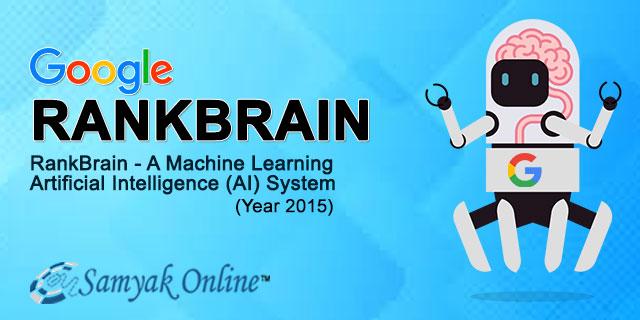
Mobilegeddon Update (Year 2015)
It was very rare that this time Google issued a two-months notice to webmasters to make their websites mobile-friendly. After the complete rollout of the Mobilegeddon update, the websites having content not adaptable for different screen sizes, too much use of flash, tough to read small texts, and closely placed clickable elements suffered heavily in ranking. Improving mobile user experience was the core intention for introducing the Mobilegeddon update.
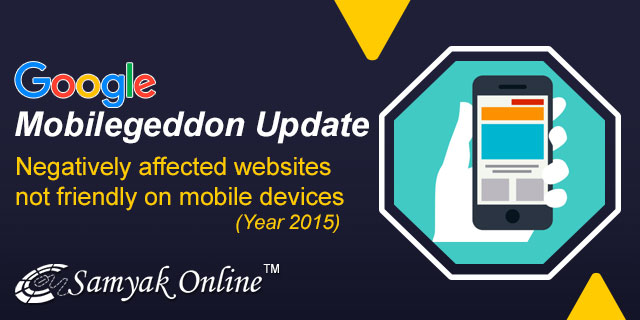
Hummingbird Update (Year 2013)
Introduction of the Hummingbird update was the overhauling of the indexing procedure Google did after the release of Caffeine. Hummingbird helped Google search engine to understand search intent and to deliver the appropriate and relevant results.
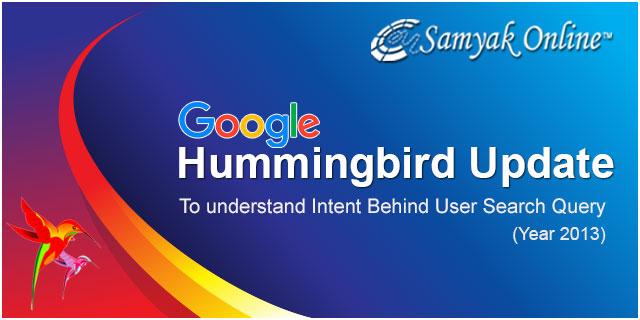
Penguin Update (Year 2012)
Penguin update, seen as an extension of Panda update, was rolled out to penalize the websites trying to manipulate rankings through black-hat SEO techniques used for quick link building. The websites having non-relevant backlinks also suffered heavily from a ranking perspective.
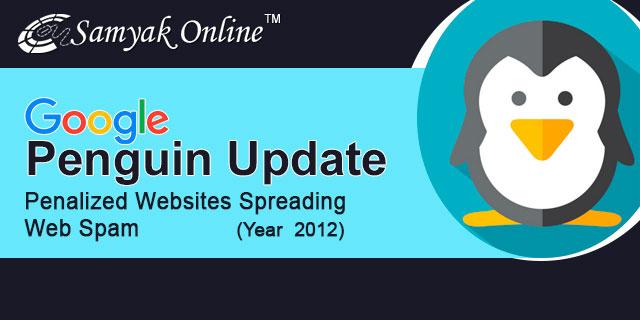
Panda Update (Year 2011)
This update was rolled out to penalize the increasing use of low-quality content and content farms. Named after Google engineer, Panda was rolled out to manage the quality drop of search results after the Caffeine update that enabled Google to index fresh content with priority. Websites having poor user metrics and repetitive content were the worst sufferers.
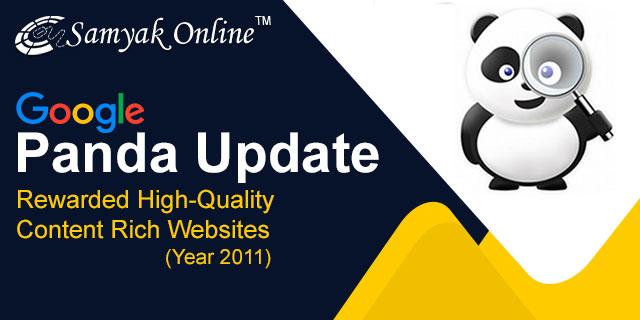
Caffeine Update (Year 2010)
Caffeine Google update did not affect the ranking of websites directly because it was related more to changing the way Google used to index the new websites. It was rolled out to index fresh and the latest information faster.
May Day Update (Year 2010)
Rolled out up to May 3, 2010, the May Day update penalized web pages having duplicate/ poor content and awarded web pages using long-tail keywords supporting Google’s mission to improve the quality of search results.
Vince Update (Year 2009)
According to Matt Cuts, named after a Google engineer, the Vince update was a small change to ranking algorithms that favored the big brands using competitive long-tail keyword terms to foster trust factor in search results of generic queries.
Rel- canonical tag (Year 2009)
An HTML tag that tells search engines about the original web page to avoid issues caused by duplicate or identical content.
Google Suggest (Year 2008)
A free tool introduced in 2007 to help its users find the phrases that best matched to the seed keyword.
Big Daddy Update (Year 2006)
It was an extension of the Jagger update. Big Daddy update was rolled out with the intention to improve the quality of search results. Google rolled out this algorithm update to penalize the websites using low-quality outbound and incoming links to improve their ranking.
Jagger Update (Year 2005)
This update penalized websites being promoted by using backlink-spamming practices. Jagger algorithms update penalized websites found having duplicate content at multiple domains, a sudden spike in the number of backlinks, irrelevant anchor text, and other “black-hat” SEO tactics. This update impacted newer websites more that were trying to establish that Google favors established sites and top brands.
Florida Update (Year 2003)
Google rolled out this algorithm update to penalize the websites, especially those of large retail stores using spam tactics like using keyword stuffing, hidden links, invisible text, etc.
Brandy Update (Year 2004)
About the inclusion of Latent Semantic Indexing (LSI) in larger index size that increased the importance of synonyms & quality links.
Toolbar PageRank (Year 2000)
Introduced in 2000, Google TBPR update facilitated website owners to see their site’s PageRank score.
Google Algorithm Major Updates Chronology (History 2000 to 2022)
| Sl. No. | Year | Google Algorithm Update | A Brief About Google Update |
| 1 | 2022 | Google May 2022 Core Update | Sites Negatively Affected having AI-generated content |
| 2 | 2022 | Product Algorithm Update | Important for eCommerce websites having reviews with multiple products |
| 3 | 2021 | Product Review Update | Two Best practices for product reviews Suggested – * Images, audio, video etc to reinforce the authenticity of eCommerce website review * Links to multiple sellers so that buyer can compare prices and buy from seller of his choice |
| 4 | 2021 | Local Search Update | Distance, Relevance, and Prominence Important ranking factors in Local Search |
| 5 | 2021 | Google Spam Update | To remove and eliminate dubious and harmful websites using Black Hat SEO techniques |
| 6 | 2021 | Link Spam Algorithm Update | Focused on sponsored guest posting, affiliate links, and paid link |
| 7 | 2021 | Page Experience Update | Core web vitals, security issues, mobile usability, popups’ experience, etc are some of the page experience signals that will contribute to fixing the web page ranking |
| 8 | 2021 | Multitask Unified Model (MUM) Update | To provide the best relevant results for each query after interpreting and analyzing videos, images, and podcasts also available in multiple languages |
| 9 | 2021 | Product Reviews Update | Aimed at product testing and product reviewing websites to support the quality trustworthy content created as per E-A-T guidelines |
| 10 | 2021 | Passage Ranking Update | Relevant-to-query passages on a web page as the additional ranking factor |
| 11 | 2020 | Google December 2020 Core Update | To improve the content interpretation and understanding of search intent |
| 12 | 2020 | Google May 2020 Core Update | Made E-A-T signals more important ranking factors |
| 13 | 2020 | Google January 2020 Core Update | Aimed to encourage businesses to improve domain-level trust |
| 14 | 2019 | BERT Update | Increased the use of NLP technology to interpret search intent and deliver the most relevant results |
| 15 | 2018 | Medic Update | Affected largely finance & health websites poor in E-A-T signals |
| 16 | 2015 | RankBrain Update | A Machine Learning Artificial Intelligence (AI) System – Favored information-rich websites relevant to search intent, personal search history, and language |
| 17 | 2015 | Mobilegeddon Update | Negatively affected websites not friendly on mobile devices |
| 18 | 2013 | Hummingbird Update | Enabled Google to understand search intent & to deliver the appropriate and relevant results |
| 19 | 2012 | Penguin Update | To stop web spam – penalized the websites using black-hat SEO techniques for quick link building. Rewarded high-quality sites |
| 20 | 2011 | Panda Update | Penalized websites using low-quality content |
| 21 | 2010 | Caffeine Update | About indexing fresh and the latest information faster to provide the users the best results with up-to-date information. |
| 22 | 2010 | May Day Update | Penalized web pages having duplicate/ poor content and awarded web pages using long-tail keywords |
| 23 | 2009 | Rel- canonical Tag | An HTML tag pointing search engines the original web page |
| 24 | 2009 | Vince Update | Favored the big brands using competitive long-tail keyword terms |
| 25 | 2008 | Google Suggest | A free tool to help users find the phrases that best matched to the seed keyword |
| 26 | 2006 | Big Daddy Update | Rolled out to penalize the websites using low-quality outbound and incoming links to improve their ranking. |
| 27 | 2005 | Jagger Update | To penalize the websites using low-quality outbound and incoming links |
| 28 | 2003 | Florida Update | Rolled out to penalize the websites using spam tactics like using keyword stuffing, hidden links, invisible text, etc. |
| 29 | 2003 | Brandy Update | Inclusion of LSI in larger index size that increased the importance of synonyms |
| 30 | 2000 | Toolbar PageRank | A Toolbar enabling website owners to see their site’s PageRank score |
FAQs
If you notice a dramatic decrease in traffic to certain web pages, it may be because of the enforcement of a new algorithm update.
If you notice a dramatic drop in website ranking all of sudden, it may be because of the Google penultimate action.
There is no standard way to improve the ranking overnight after being hit by an algorithm Google update. However, there are certain effective ways to improve the SERP ranking organically in a short period- Explore and understand the latest update, improve the content accordingly, conduct a website audit to remove pitfalls and go steady with patience with white-hat SEO and SMM.
Most of the time, Google does not inform about the forthcoming algorithm update; therefore, you can’t be sure of not having any impact by the future update. However, I recommend a few time-tested practices to face Google updates successfully having the least impact on ranking- keep exploring Google blogs, focus on E-A-T in SEO (Expertise, Authoritativeness, and Trustworthiness), get website audit periodically, improve content optimization continually, and be responding on social media platforms, etc.
Yes. Rolling out ranking algorithms updates is an unabated policy of Google to improve the experience of its users. As improvement is a continuous process, you can expect more Google updates in the years 2022, 2023, and after as you witnessed in previous years.
Please explore the chronology of Google algorithm updates given above that massively reshuffled website ranking. The listed algorithm updates still play a key role in deciding your website ranking.
About Author:
Subhash Jain is the Founder of Samyak Online – the top SEO agency in India. Are you looking for SEO services to increase your website traffic, leads and brand recognition? Contact us for Free SEO Proposal.


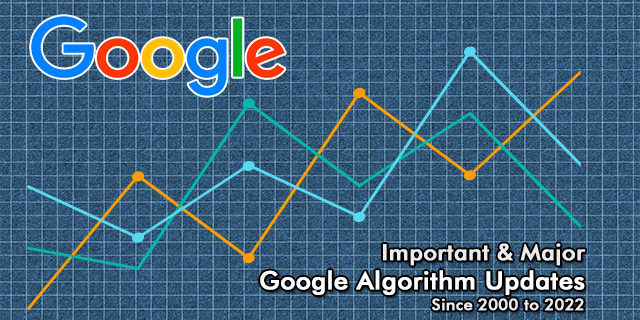
Leave a Reply
Want to join the discussion?Feel free to contribute!